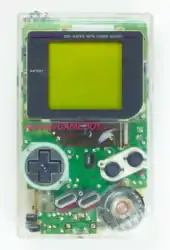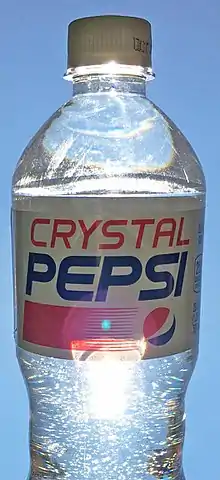Clear craze
The clear craze was a marketing fad in the late 1980s and 1990s, equating clarity with purity. Inspired by Ivory's "99 and 44/100 percent pure" campaign for bath soap, and by low-calorie or "light" beverages, sodas were redesigned in the 1980s and 1990s as being free of artificial dyes, such as the caffeine-free and preservative-free Crystal Pepsi. Personal hygiene products were then relaunched as clear dye-free gels, and many electronics have transparent cases.
History

Since the introduction of Plexiglas in the late 1930s, devices have been made with clear shells to expose the electromechanical components inside. At the 1939 New York World's Fair, a 139 Pontiac Deluxe Six engine with a clear Plexiglas body was on display.[1][2] Peaking in the 1960s and 1970s, transparent-shelled devices fell out of fashion until the clear craze in the late 1980s. Following the breakup of the Bell System in the mid 1980s, a surge of manufacturers began creating phones, many of them transparent and having flashing neon lights when the phone rang.[3]
A trend of "light" beer with fewer calories started in the 1960s. Then, color was identified in the marketing industry as a "tool for visual persuasion" toward a product's purity and health consciousness. Ivory soap was adapted from its classic milky solution and its slogan of "99 and 44/100 percent pure".[4] This led up the clear craze starting in the 1980s. To showcase the reduction of calories or artificial flavors, many companies released clear versions of their products. The clear cola market was entered by Crystal Pepsi on April 13, 1992[5] featuring no preservatives or caffeine, although the existing Pepsi also did not have preservatives, and a caffeine-free version was already available.[4][6] Coca-Cola soon responded with Tab Clear.[7] In August 1992, Coors announced Zima, a clear, carbonated malt beer and in 1993, Miller released Miller Clear, a clear variant of their beer to mixed reviews.[8]
Gillette released versions of its existing deodorants and shaving creams in a clear gel form which is still in use today.[9]
Through the 1990s, the clear trend continued with transparent watches, staplers, calculators, handheld gaming devices such as the Nintendo Game Boy,[10] and computers such as Apple's iMac.
 Crystal Pepsi.
Crystal Pepsi. A translucent indigo iMac G3.
A translucent indigo iMac G3. A translucent orange Nintendo 64.
A translucent orange Nintendo 64.
References
- Joslin, Tom (July 31, 2011). "See-through 1939 Pontiac sells for $308,000". Jalopnik.
- "Ghost Car -- A 1939 Plexiglas Pontiac Deluxe Six -- To Be Auctioned". Huff Post. July 6, 2011.
- "April 26, 1990, 13 - The Daily Journal at Newspapers.com".
- Garber, Jr., Lawrence L. (2003). "Color as a Tool for Visual Persuasion". In Linda M. Scott (ed.). Persuasive Imagery: A Consumer Response Perspective. Lawrence Erlbaum Associates. p. 313. ISBN 0-8058-4202-0. Retrieved February 12, 2020.
- "Business Digest". The New York Times, April 13, 1992
- Zyman, Sergio. The End of Marketing as We Know It. Harper-Collins, 1999. ISBN 0-88730-983-6
- "February 15, 1993, 35 - The Morning Call at Newspapers.com".
- "June 27, 1993, 5 - The News Leader at Newspapers.com".
- "February 15, 1993, 42 - The Morning Call at Newspapers.com".
- "October 8, 1996, Page 30 - Arizona Republic at Newspapers.com".
External links
- Clear, and cashing in, Newsweek, February 2, 1993